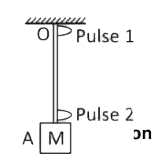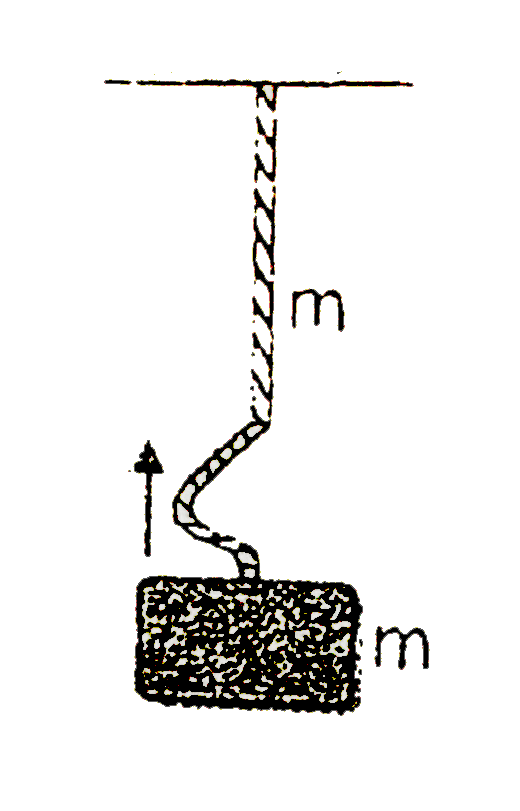A block M hangs vertically at the bottom end of a uniform rope of constant mass per unit length. The top end of the rope is attached to a fixed rigid support at O. A transverse wave pulse (Pulse 1) of wavelength λ0 is produced at point O on the rope. The pulse takes time TOA to reach point A. If the wave pulse of wavelength λ0 is produced at point A (Pulse 2) without disturbing the position of M it takes time TAO to reach point O. Which of the following options is/are correct?

The velocities of the two pulses (Pulse 1 and Pulse 2) are the same at the midpoint of rope
The velocity of any pulse along the rope is independent of its frequency and wavelength
The wavelength of Pulse 1 becomes longer when it reaches point A
The time TAO=TOA
The correct Answer is:B, D
Velocity of the wave depends upon the trnsion in the rope and mass per unit length of the rope. ⇒ velocity is dependent of frequency and wavelength
option (B) is correct
since tension at the point is same .therefore speed at the point will also be same.Option(A) is correct since the dirsction of the motion of pilses is opposite .,velocitis will be equal and opposite.with this point of view A will be incorrect since the velocities at position dependent only on tension at every point (μ=constant)therefore time taken for the wave the reach A from O and O from A will be same.
TOA=TAO
Option (D) is correct
v=λv
since v depends on source
⇒λ∝v⇒λ∝√T
Tension decreases as we move from O to A ,therefore λ becomes shorte. Option (C) is icorrect.
Similar Questions
A uniform rope of mass 6 kg and length 6 m hangs vertically from a rigid support. A block of mass 2 kg is attached to the free end of the rope. A transverse pulse of wavelength 0.075 m is produced at the lower end of the rope. The wavelength of the pulse when it reaches the top of the rope is K cm where K is
09:19View SolutionA uniform rope of length 10 m and mass 3 kg hangs vertically from a rigid support. A block of mass 1 kg is attached to the free end of the rople. A transverse pulse of wavelength 0.05 m is produced at the lower end of the rope. The wavelength of the pulse when it reaches the top of the rope is
View SolutionA uniform rope of length 12 mm and mass 6 kg hangs vertically from a rigid support. A block of mass 2 kg is attached to the free end of the rope. A transverse pulse of wavelength 0.06 m is produced at the lower end of the rope. What is the wavelength of the pulse when it reaches the top of the rope?
03:40View SolutionA uniform rope of length 12 mm and mass 6 kg hangs vertically from a rigid support. A block of mass 2 kg is attached to the free end of the rope. A transverse pulse of wavelength 0.06 m is produced at the lower end of the rope. What is the wavelength of the pulse when it reaches the top of the rope?
04:54View SolutionA uniform rope of length 12 m and mass 6 kg hangs vertically from a rigid support. A block of mass 2 kg is attached to the free end of the rope. A transverse pulse of wavelength 0.06 m is produced at the lower end of the rope. What is the wavelength of the pulse when it reaches the top of the rope ?
03:39View SolutionA uniform rope of length 12 mm and mass 6 kg hangs vertically from a rigid support. A block of mass 2 kg is attached to the free end of the rope. A transverse pulse of wavelength 0.06 m is produced at the lower end of the rope. What is the wavelength of the pulse when it reaches the top of the rope?
04:31View SolutionA uniform rope of length 10 cm and mass 4 kg hangs vertically from a rigid support. A block of mass 2 kg is attached to the free end of the rope. A transverse pulse of wavelength 0.06 m is produced at the lower end of the rope, what is the wavelength of the pulse when it reaches the top of the rope?
05:53View SolutionA uniform rope of elngth l and mass m hangs vertically from a rigid support. A block of mass m is attached to the free end of the rope. A transverse pulse of wavelength λ is produced at the lower end of the rope. The wavelength of the pulse, when it reaches the top of the rope. is aλ. Find a2
 02:26View Solution
02:26View Solution

